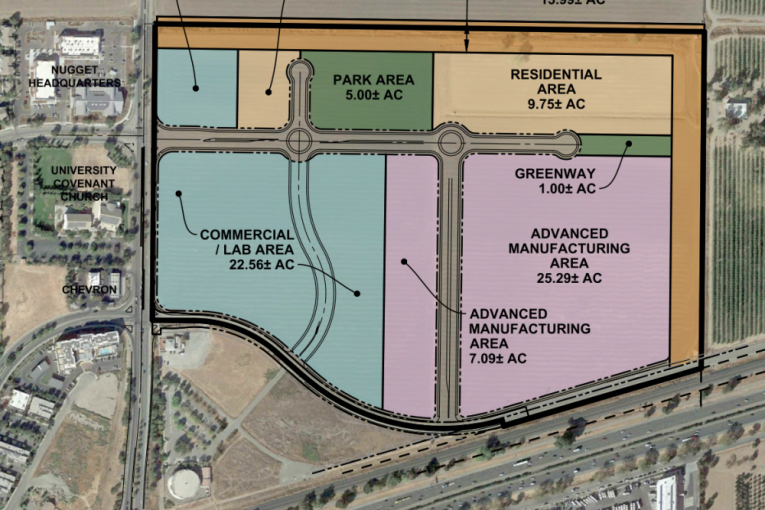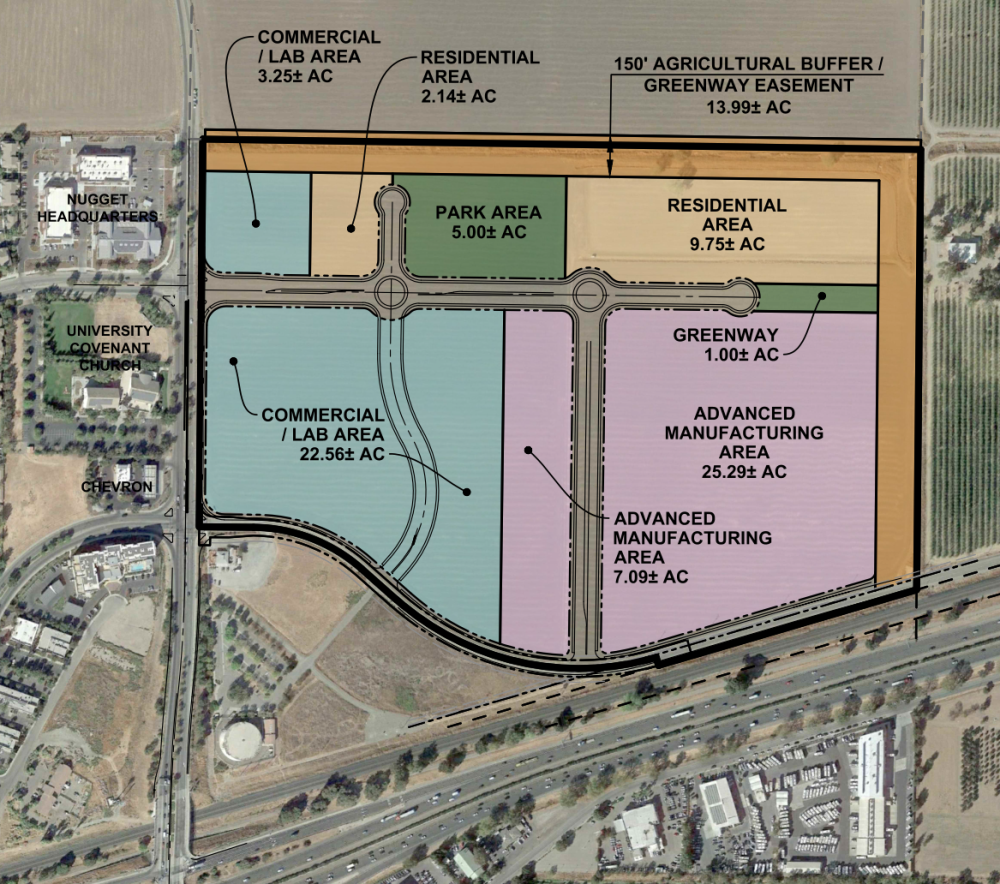

By David M. Greenwald
Executive Editor
Davis, CA – Ever since DISC came back in 2019-20 and added a residential component, we have heard critics charge that DISC has morphed from a business park into a residential project. Certainly when you saw the original project back in 2020 with 850 residential units, it’s easy to think about it as much as a residential project as a commercial one, but I don’t think that’s true.
The history of the innovation park concept and the proposals that came out in 2013 and 2014 was that, at the time, we were just coming out of the Great Recession and the real estate collapse. There was a sense that the voters would not support residential projects and that housing would therefore kill any proposal.
But the world of 2020 and now 2022 looks very different from 2013-14. We have a housing shortage. We have seen the voters of Davis approve two housing projects and, moreover, many believe or at least at one point believed that housing and affordability are at the  top of the list of problems in the city.
top of the list of problems in the city.
Even with the revised project, does it really make sense to add 4100 potential employees to a site without adding housing? Ironically a lot of the people who said they might have supported the project without housing are similar to the ones who are arguing that DISC is adding too much in the way of traffic congestion, VMT and carbon footprint.
Some have also questioned whether we have added enough housing on site to meet the demands of the anticipated employees. Personally, I would have gone higher with housing, even at the risk of more concern over traffic and impact.
One question that some have raised is whether DISC will potentially induce substantial population growth.
When DiSC 2022 came back with a significantly reduced footprint, it saw a 63.6 percent decrease in commercial square footage, a 37.8 percent reduction in advanced manufacturing square footage, a 45.9 percent decline in on-site residential units, and a 20 percent reduction in ancillary retail square footage.
The original plan called for 5882 employees and the SEIR determined that it would need to build 815 additional housing units to serve the projected employee population.
To calculate this, the SEIR “estimated that employee housing demand at buildout of the DISC project would have been 3,763 households.”
Based upon empirical commute patterns for Davis area employees, “the SEIR assumed 45.4 percent of new DISC employees would have sought housing outside of the City, with 54.6 percent of new DISC employees living in Davis.”
The SEIR determined, “After accounting for City of Davis residential unit capacity, the SEIR determined that of the 2,053 units demanded by DISC project employees within the City, the project would have needed to provide approximately 815 units.”
DISC therefore met its housing need by providing 850 housing units.
They determined, based on this analysis, “the increase in housing demand associated with the DISC project could have been met within the City rather than the surrounding SACOG region.”
Further, “the DISC project would have provided secondary environmental benefits associated with on-site residential opportunities, such as reduced VMT on regional roadways, as well as potentially reducing the amount of regional residential development needed to support the employees generated from the DISC project.
“Therefore, the SEIR concluded the DISC project would not have induced substantial population growth.”
For the new project, they downwardly projected the number of employees.
Based upon the calculations used in the SEIR to determine the number of employees the DISC project would have generated, “the DiSC 2022 project would generate an estimated 2,800 employees (reduced from 5,882 previously analyzed), which would result in a housing demand at buildout of approximately 1,729 units (reduced from the 3,763 previously analyzed).”
Using the same 54.6 percent estimate, the EIR calculates “a reduced amount of approximately 944 units would be required in Davis to accommodate the increased housing demand from DiSC 2022 employees.”
The EIR notes that the City has adopted the 2021-29 Housing Element—although we now know the HCD has not accepted that and has some serious questions about the city’s ability to fill its housing needs. Nevertheless, at some point the city will have an implemented housing element with a capacity of 2,755 units from planned and approved projects, exceeding the Regional Housing Needs Allocation of 2,075 units.
The EIR notes, “A total of 2,088 of the planned and approved units are proposed for moderate—or above moderate—income units, which are likely to align with the incomes of most DiSC 2022 employees. With that capacity, the raw demand for housing in Davis generated by DiSC 2022 could be met with the existing planned and approved units and, as such, the project does not induce a need for increased housing construction.”
This analysis is certainly not going to convince those who believe that this is primarily a housing project and will likely not convince those who believe that DiSC 2022 will be growth-inducing, but it seems, as I have believed all along, that normally anticipated growth in the city should accommodate housing needs from this project—and the SEIR only analyzes the next Housing Element cycle, whereas with a 20-year build out, this project could take place over two or three cycles.
In short, I don’t see that this project poses a problem for housing needs in Davis.


DISC is amazing.
It’s not growth inducing and “you could even reasonably argue that this project could result in a net reduction of global GHG emissions”. At least that’s what the Vanguard is telling us.
And when Trackside came back with a four-story building, it had 67% less as many floors! Nothing like comparatively reducing the impacts relative to something that has never existed.
For me, I won’t vote for DISC (or DiSC now for some reason) unless it has housing. Build housing, build a bike tunnel under Mace, and place the bus bays on either side of the bike tunnel, and the developers have my vote. (I’d also prefer each apartment unit has natural gas heating and a wood-burning fireplace with brick chimneys, but I’ll let those slide).
And yet why, with every of the several-per-week, hammer-over-the-head ‘support’ articles in the Vanguard, do I feel ever less inclined to vote yes?
That’s how the game is often played.
I was thinking the same thing, is the Vanguard helping or actually hurting the chances of DISC getting approved?
Yes.
Yeah, I’m feeling the hit over the head with a hammer about this subject and project too….and I sort of support it.
So the question for you is what do you want to hear about DISC, Davis housing…..growth or lack of growth?
I think all those subjects have already been covered ad nauseam.
That’s definitely a downside of having a second go around for a Measure J project.
Yeah, but you have to remember the old axiom… question, “Why do you keep hitting your head with a hammer?” Answer, “It feels so good when I stop!”
I’m gonna use that one.
Had forgotten that it was proposed as 12 stories… must have missed that story… woulda’ have to have gotten a really huge ladder truck for that!
BTW, what action, if any, did CC take on the ladder truck, David? Too busy playing cribbage to watch the meeting…
I’m working on a story on that, but they approved it, option 3.
Thx…
Was there ever any doubt?
Not really. It was pretty clear when the issue came up last spring that it had council support.
WM, 4/6 = 67%; six not 12; OK, my purposeful use of gibberish ‘less as many’ didn’t help with the math.
So that’s 33% less last time I did 5th grade math…
Did they use gibberish in 5th grade math . . . of?
And yet, using the numbers in David’s own article demonstrates the problem.
There’s lots of numbers thrown-around in this article, to the point that it seems purposefully-confusing. I’d suggest laying out the numbers and assumptions in a more clear manner.
But the bottom line is that DISC “uses up” a lot of the housing element, and also results in additional commuting from the units which would not be built in Davis.
David’s argument (which I find disgusting, given his stated concerns) is that there is “no demand” for housing other than what DiSC would create. Which is the opposite of what he usually states (even within this same article)!
It’s this type of argument which undermines the credibility of the Vanguard, itself.
I
By the way, the following baseline feature is apparently “missing” from this version of DiSC. It was in the earlier version:
There’s quite a few other changes to baseline features, as well:
https://www.davisite.org/2022/01/dramatic-reduction-in-baseline-features-in-disc-2022.html